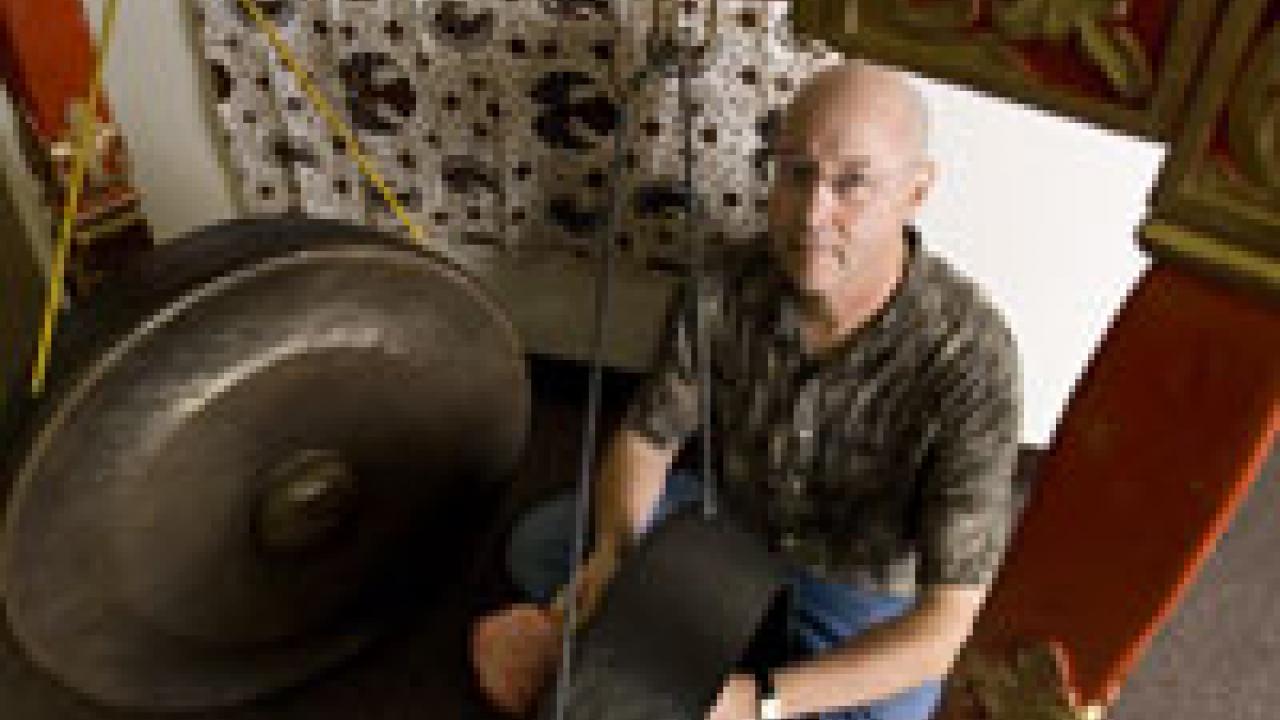What do gongs, xylophones, funny hats, music students and a world-class Indonesian vocalist have in common?
They are elements of an ensemble — music professor Henry Spiller's new "gamelan" ensemble, that is.
The word gamelan comes from the Javanese word "gamel," meaning to strike or hammer. Gamelan music is conjured with xylophones, gongs and drums, along with Indonesian instruments with odd names like rebabs, sarons and bonangs. These exotic, carved wooden and bronze instruments are like few others, and you can quickly paint a picture of how stunning, both visually and acoustically, high-energy gamelan performances can be.
Spiller, an ethnomusicologist hired last year, started up the UC Davis Gamelan Ensemble soon after arriving on campus. He has high hopes for teaching students about the musical form and introducing it to the community.
"I think it will bring a new facet to the music department's offerings," said Spiller. "We've been trying to have non-Western ensembles that are also high profile."
That profile heightens at 8 p.m. April 21, when Spiller's gamelan ensemble takes the stage for the first time at the Mondavi Center. The debut will also feature Sundanese singer Euis Komariah, the top classical singer in West Java, and Ben Arcangel, a dancer trained in Sundanese dance.
For Spiller, the group is about more than music — it showcases another culture to the community. And there is deep value in this, he said. Spiller is particularly interested in investigating how people employ music and dance in their personal lives to articulate ethnic, gender and national identities. Gamelan offers him a window into that relationship between culture and music.
Phillip Front, a third-year music major, said, "In the music program, we do not learn much about ethnomusicology. And I wanted to learn about other cultures."
Spiller said his reason for beginning the ensemble was not entirely academic or even community-oriented. As a musician, he simply loves the sounds — and camaraderie — of gamelan music.
"I like to play it," he said. "And you can't play alone."
Indeed, being a member of a gamelan ensemble is a highly social activity. Most gamelan instruments do not require prodigious skills to master — the way the music is played de-emphasizes technical mastery. And so, the interlocking nature of the instrumental sounds feeds off of group energy.
And there is a certain rebellious quality in gamelan, said Spiller.
"The music is not virtuosic," he said. "You don't have to be a great musician to play well. But you have to be a social musician and be able to respond to things around you."
Spiller discovered Indonesian music when he was an undergraduate at UC Santa Cruz. He heard a gamelan ensemble led by a Santa Cruz lecturer, Undang Sumarna. Those sounds, coming at him through the classroom wall, changed his life. Soon he began studying gamelan and Sundanese music, enrolling in graduate school to study ethnomusicology, only to drop out and take a 10-year hiatus from music to work as a computer programmer.
But his passion for gamelan still burned within, and one day Spiller returned to school. He enrolled at UC Berkeley and earned his master's and doctorate in ethnomusicology. Since then, he has visited Indonesia several times, learned how to play a variety of gamelan instruments, taught gamelan at Mills College in Oakland and written a book, Gamelan: The Traditional Sounds of Indonesia.
Perhaps it seems strange that a gamelan aficionado would accept a teaching position at a school like Davis that does not offer an Indonesian music scene. But after teaching Asian music at Kenyon College in Ohio, Spiller longed to return to Northern California. Finally, he was ready to share his musical fascination with the community, on and off campus.
"Gamelan is something lots of people can participate in," Spiller said.
He pointed out that gamelan ensembles are popular in the Netherlands, Argentina, Israel, Japan, Singapore and Canada. And the style has influenced a variety of Western musicians: Philip Glass, Claude Debussy and even the Grateful Dead's Mickey Hart. Gamelan is present within the UC universe, popping up in ensemble form at UCLA, Santa Barbara, Berkeley, Riverside and Santa Cruz.
Back at Davis, Spiller is eager to see how his students will perform. They are a diverse group in age, ethnicity, academic interest and skill level. While some are music majors seeking exposure to world music, others want to learn more about their Southeast Asian heritage. And some just find it to be "cool" music.
"It's something I've never done before," said Lorena Rincon, a senior psychology major and novice gamelan player. "I thought it would be a good experience."
Oh, and those funny hats? Gamelan musicians typically wear head cloths made of batik fabric called "bendos."
For tickets to the April 21 show, call (530) 754-2787 or visit www.mondaviarts.org. Other upcoming Southeast Asian cultural attractions include Sacramento State's Javanese puppet show on Feb. 24, and workshops by Sekar Jaya, a long-running Balinese gamelan group in El Cerrito (for the latter, see www.gsj.org). Allison Leung is a writing intern for Dateline.
Media Resources
Clifton B. Parker, Dateline, (530) 752-1932, cparker@ucdavis.edu
